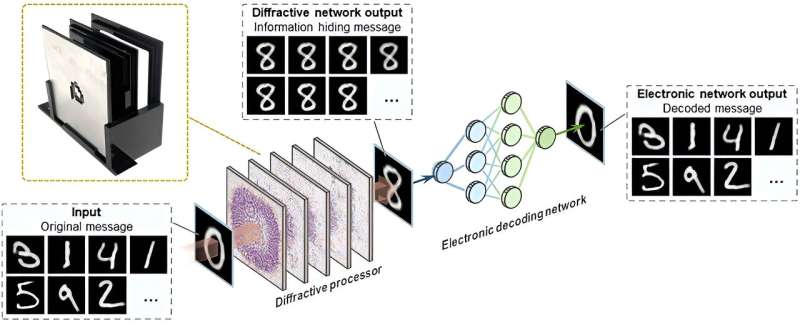
JUNE 13, 2024 by UCLA Engineering Institute for Technology Advancement
Collected at: https://techxplore.com/news/2024-06-camera-optical-technology-conceals-plain.html
Researchers at the University of California, Los Angeles (UCLA) have developed an innovative information-hiding camera to optically transform and conceal input images into ordinary-looking patterns, providing a powerful solution for visual information security. The work is published in the journal Science Advances.
The UCLA team introduced an information-hiding camera that integrates an optical encoder with an electronic decoder, jointly optimized through deep learning. This novel system optically transforms sensitive input images into seemingly ordinary patterns, concealing information from unintended observers while allowing secure decoding by authorized users.
The research, led by Aydogan Ozcan, Chancellor’s Professor and Volgenau Chair for Engineering Innovation at UCLA, represents a significant advancement for visual data privacy. Their work addresses the growing need for secure communication methods that do not attract attention by signaling the presence of hidden information.
How it works
The core of this technology is a diffractive optical processor that manipulates light to optically transform input images into ordinary-looking patterns. This optical transformation occurs through passive light-matter interactions within the processor, making it both high-speed and energy-efficient. The concealed information can then be accurately reconstructed using an electronic decoder network trained alongside the optical encoder.
The researchers demonstrated the effectiveness of their approach by designing cameras that operate under various lighting conditions and noise levels. They also extended the design to multi-spectral operation, allowing for the simultaneous concealment and decoding of multiple images at different wavelengths.
Practical applications
This information-hiding camera offers numerous practical applications, particularly in scenarios where digital communication security is paramount. Unlike traditional cryptographic methods that use encrypted messages and can draw attention, this system all-optically conceals data behind ordinary images, making it an ideal solution for covert information transmission.
“Cryptography and steganography have long been used to protect sensitive data, but they have limitations, especially in terms of data embedding capacity and vulnerability to compression and noise,” explained Dr. Ozcan, the study’s corresponding author.
“Our optical encoder-electronic decoder system overcomes these issues, providing a faster, more energy-efficient, and scalable solution for information concealment.”
The team validated their framework experimentally using terahertz (THz) radiation. They successfully fabricated a diffractive layer using 3D printing, demonstrating the experimental feasibility of the system. These experimental results closely matched the numerical simulations, showcasing the system’s robustness and accuracy.
Future prospects
This research opens up new possibilities for secure visual data processing and communication. The adaptability and robustness of the system make it suitable for various applications, from secure communications in sensitive fields to everyday digital privacy solutions. The team envisions future enhancements, including multi-user secret communication and additional layers of security through electronic encryption.
“Our approach represents a significant step forward in the integration of optical and electronic systems for secure data processing,” said Dr. Ozcan. “We are excited about the potential applications and look forward to further developing this technology.”
More information: Bijie Bai et al, Information-hiding cameras: Optical concealment of object information into ordinary images, Science Advances (2024). DOI: 10.1126/sciadv.adn9420
Journal information: Science Advances

Leave a Reply